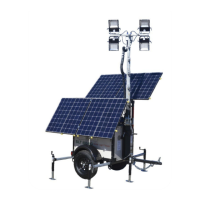4. Configuration
Once the electrical connections have been made, and the battery monitor has been powered up, it needs to be configured to be
suitable for the system it is used in.
This can be done with the buttons on the battery monitor head unit or even easier via the V
ictronConnect app.
This chapter describes how to configure the battery monitor by making the basic settings. See the All features and
settings [28] chapter for all settings and features.
4.1. Setup wizard
The battery monitor will automatically start the setup wizard on the first power-up or after a factory reset. The setup wizard must
be completed before any other settings are made.
Alternatively, use the VictronConnect app to configure the battery monitor. This will override the setup wizard.
1. The display shows the scrolling text "battery capacity":
.
2.
Press any button to enter the setup wizard. The scrolling text will stop, and the factory default battery capacity value
(200 Ah) will be shown with the first digit blinking.
3.
Use the + and – buttons to set the first digit of the battery capacity value. Preferably use the 20-hour (C20) battery capacity
rating. For more information on battery capacity, see the Battery capacity and Peukert exponent [44] chapter.
4. Press SELECT to set the next digit in the same manner. Repeat this step until the required battery capacity is displayed.
5. Press SELECT to store the value. A short beep confirms this.
Should a correction need to be made, press SELECT again and repeat the previous steps.
6. Press SETUP, + or – to proceed to the auxiliary input setting.
7. The display will show the scrolling text
(auxiliary input).
8.
Press SELECT to stop scrolling, and the LCD will show:
(start).
9.
Use the + or – buttons to select the required function of the auxiliary input:
(start) for monitoring the starter battery
voltage. (mid) for monitoring the midpoint voltage of a battery bank. (temp) for using the optional temperature
sensor
.
10. Press SELECT to store the value. A short beep confirms this.
Should a correction need to be made, press SELECT again and repeat the previous step.
11. Press the SETUP, + or – button to end the setup wizard and switch to the normal operating mode.
Immediately after the completion of the setup wizard, the battery monitor will automatically detect the nominal voltage of the
battery system. For details and limitations of automatic voltage detection, see the next chapter Automatic voltage detection [12].
The battery monitor is now ready for use. It is now set up for an average system with GEL, AGM or flooded lead-acid batteries.
Further battery monitor configurations are required if your system contains a battery with different chemistry, like lithium, or if other
specific system settings are needed. See the All features and settings [28] chapter.
If the setup wizard is not showing, i.e. there is no scrolling text, it can be re-activated by performing a battery
monitor reset. T
o do this: simultaneously press the SETUP and the SELECT button for 3 seconds. This resets
the battery monitor to its factory settings.
Note that factory settings can only be restored if the Lock setup [39] setting has been set to OFF.
4.2. Automatic voltage detection
The battery monitor will automatically adjust itself to the nominal voltage of the battery bank. This happens immediately after
the completion of the setup wizard. The below table shows how the nominal voltage is determined and to what nominal battery
voltage the battery monitor is automatically set. See the Set charged voltage value
[15] chapter for more information.
Measured voltage Assumed nominal voltage
< 18V 12V
18 - 36V 24V
Manual - BMV-712 Smart
Page 12 Configuration

